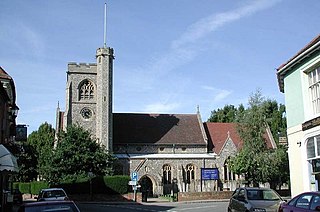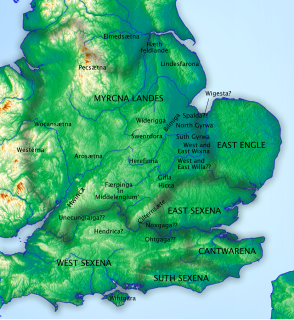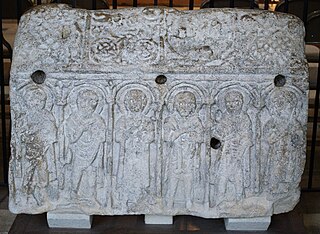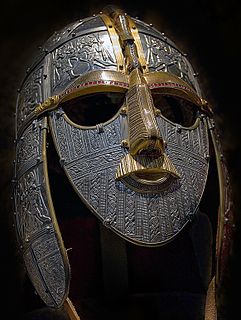The Waeclingas (Old English Wæclingas) were a tribe or clan of Anglo-Saxon England. Their territory or regio was based in the modern city of St Albans, whose name is recorded as Wæclingaceaster ("the former Roman fortification of the Wæclingas") in the writings of Bede in the early 8th century, and in an early 10th century Anglo-Saxon charter. [1] Before the territory came under Mercian control around 660 it may have formed part of the province of the Middle Saxons, or it may have fallen under the influence of the Kingdom of Essex – neither is certain. [2]
Old English, or Anglo-Saxon, is the earliest historical form of the English language, spoken in England and southern and eastern Scotland in the early Middle Ages. It was brought to Great Britain by Anglo-Saxon settlers probably in the mid-5th century, and the first Old English literary works date from the mid-7th century. After the Norman conquest of 1066, English was replaced, for a time, as the language of the upper classes by Anglo-Norman, a relative of French. This is regarded as marking the end of the Old English era, as during this period the English language was heavily influenced by Anglo-Norman, developing into a phase known now as Middle English.
Regiones or provinciae,(singular: provincia), also referred to by historians as small shires or early folk territories, were early territorial divisions of Anglo-Saxon England, referred to in sources such as Anglo-Saxon charters and the writings of Bede. They are likely to have originated in the years before 600, and most evidence for them occurs in sources from or about the 7th century.

St Albans is a city in Hertfordshire, England, and the major urban area in the City and District of St Albans. It lies east of Hemel Hempstead and west of Hatfield, about 20 miles (32 km) north-northwest of central London, 8 miles (13 km) southwest of Welwyn Garden City and 11 miles (18 km) south-southeast of Luton. St Albans was the first major town on the old Roman road of Watling Street for travellers heading north, and it became the Roman city of Verulamium. It is a historic market town and is now a dormitory town within the London commuter belt and the Greater London Built-up Area.
The name of the tribe comes from a personal name, meaning "the people of Wæcla". [1] The tribe gave their name to Watling Street, the former Roman road from London to St Albans. [1] The small town of Watlington in South Oxfordshire is also said to derive its name from the Waeclingas.

Watling Street is a route in England that began as an ancient trackway first used by the Britons, mainly between the areas of modern Canterbury and St Albans using a natural ford near Westminster. The Romans later paved the route, which then connected the Kentish ports of Dubris (Dover), Rutupiae (Richborough), Lemanis (Lympne), and Regulbium (Reculver) to their bridge over the Thames at Londinium (London). The route continued northwest past Verulamium (St Albans) on its way to Viroconium (Wroxeter). The Romans considered the continuation on to Blatobulgium (Birrens) beyond Hadrian's Wall to be part of the same route, leading some scholars to call this Watling Street as well, although others restrict it to the southern leg.

London is the capital and largest city of both England and the United Kingdom. Standing on the River Thames in the south-east of England, at the head of its 50-mile (80 km) estuary leading to the North Sea, London has been a major settlement for two millennia. Londinium was founded by the Romans. The City of London, London's ancient core − an area of just 1.12 square miles (2.9 km2) and colloquially known as the Square Mile − retains boundaries that follow closely its medieval limits. The City of Westminster is also an Inner London borough holding city status. Greater London is governed by the Mayor of London and the London Assembly.

Watlington is a market town and civil parish about 7 miles (11 km) south of Thame in Oxfordshire, near the county's eastern edge and less than 2 miles (3 km) from its border with Buckinghamshire. The parish includes the hamlets of Christmas Common, Greenfield and Howe Hill, all of which are in the Chiltern Hills. The 2011 Census recorded the parish's population as 2,727.
The tribal territory of the Waeclingas may have corresponded to the territory of the municipium of Verulamium, the Romano-British town that preceded St Albans. [3] Together with the Brahhingas and the Hicce the Waeclingas were one of the most important tribes of the area that would later become the county of Hertfordshire, and its territory would evolve into some of the structures that would form the county's administrative framework. [1]
Municipium was the Latin term for a town or city. Etymologically the municipium was a social contract between municipes, the "duty holders," or citizens of the town. The duties, or munera, were a communal obligation assumed by the municipes in exchange for the privileges and protections of citizenship. Every citizen was a municeps.

Verulamium was a town in Roman Britain. It was sited in the southwest of the modern city of St Albans in Hertfordshire, Great Britain. A large portion of the Roman city remains unexcavated, being now park and agricultural land, though much has been built upon. The ancient Watling Street passed through the city. Much of the site and its environs is now classed as a scheduled ancient monument.
The Brahhingas or Brahingas were a tribe or clan of Anglo-Saxon England whose territory was centred on the settlement of Braughing in modern-day Hertfordshire. The name of the tribe means "the people of Brahha", with Brahha likely to have been either a leader of the tribe or a real or mythical ancestor.












